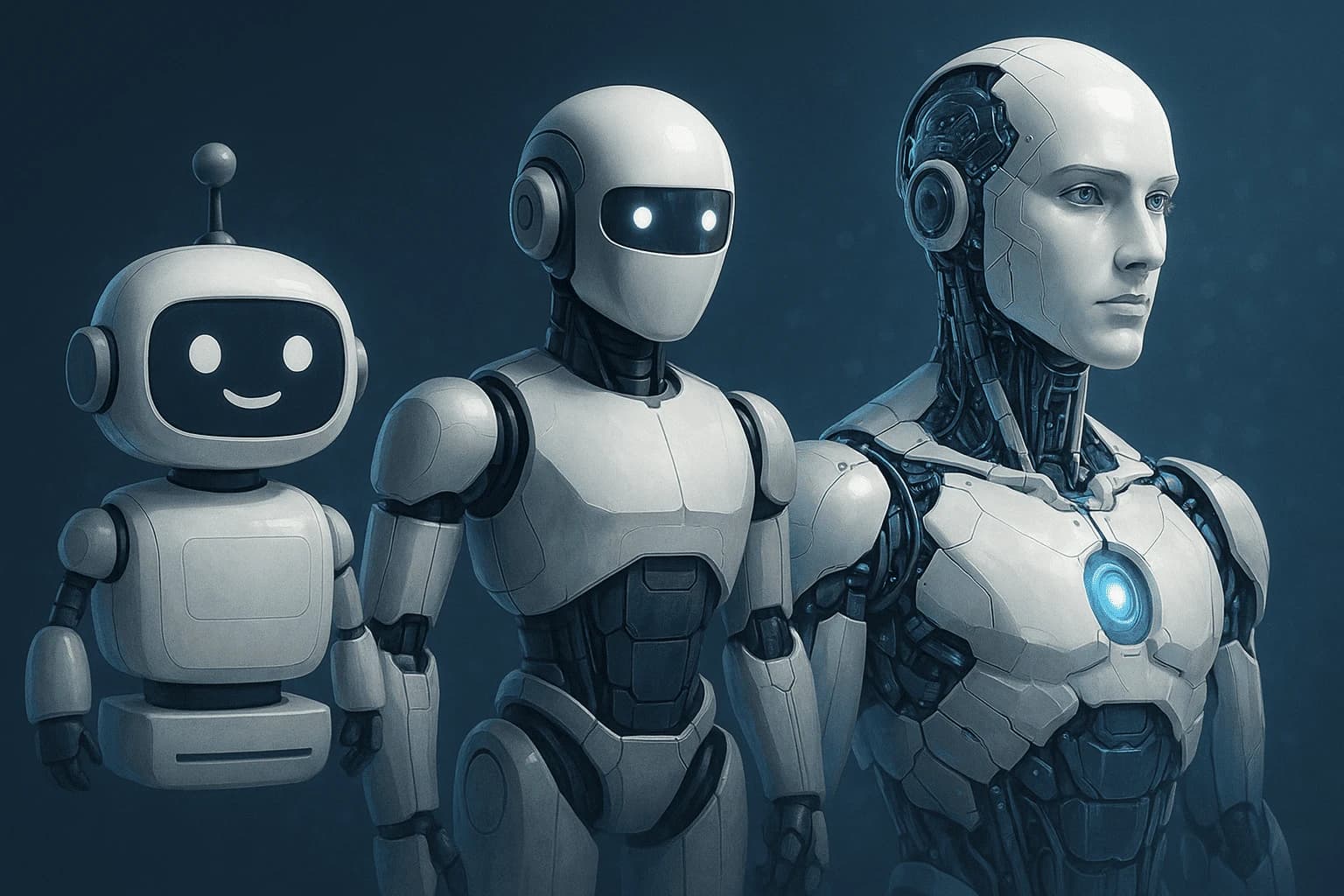
* All product/brand names, logos, and trademarks are property of their respective owners.
In just a few decades, artificial intelligence has made a dramatic leap—from rule-based chatbots that could only parrot back scripted responses to intelligent, goal-oriented agents capable of making decisions, learning autonomously, and potentially evolving into Artificial General Intelligence (AGI). This transformation isn’t just a technical milestone—it marks a fundamental shift in how machines understand, interpret, and interact with the world around them.
At the heart of this journey is the AI agent: a system designed to perceive its environment, make decisions, and take actions to achieve specific goals. The evolution of AI agents reflects the broader progress of AI as a whole. Early bots like ELIZA were groundbreaking in their time, mimicking human interaction through scripted patterns. But as expectations and data grew, these systems quickly showed their limitations.
Fast forward to today, and we now see the rise of agentic AI—systems that are not just reactive, but proactive. These agents, powered by large language models (LLMs) and sophisticated architectures, can plan, reason, and even collaborate with other agents to complete complex workflows. Tools like AutoGPT, Devin, and MetaGPT exemplify this next generation, functioning more like digital coworkers than simple assistants.
And then there’s the holy grail: AGI. The dream of building machines with human-like understanding, reasoning, and creativity. While we're not there yet, today’s AI agents are undeniably laying the foundation for it.
In this blog, we’ll explore how we got here—from simple scripts to autonomous systems—and where we might be headed next. Whether you're a developer, a business leader, or just curious about the future of AI, understanding this evolution is essential.
AI didn’t start with agents that can reason or collaborate—it started with chatbots that followed strict rules. These early systems were more like mirrors, reflecting pre-programmed responses rather than engaging in real understanding. But they were critical first steps in the long road to AGI.
In the 1960s, ELIZA, one of the first AI programs, simulated a psychotherapist by matching user inputs to a script of pre-written responses. It wasn’t truly “intelligent,” but it gave the illusion of understanding, and that alone sparked immense curiosity. Later came ALICE, which used Artificial Intelligence Markup Language (AIML) to produce more diverse interactions—but it still relied entirely on predefined rules.
These early chatbots were deterministic—they couldn’t learn, adapt, or understand context. Their knowledge was static, and their ability to hold a conversation was severely limited. Yet they introduced the world to the possibility of machine communication.
The breakthrough came with the integration of Natural Language Processing (NLP). Systems like Apple’s Siri (2011), Amazon Alexa (2014), and Google Assistant (2016) began interpreting natural human language using machine learning and statistical models. These tools could answer questions, set reminders, and perform tasks based on user prompts.
Unlike rule-based bots, these conversational AI assistants started incorporating real-time data and contextual awareness. NLP enabled machines to understand syntax, semantics, and even user intent—ushering in a more interactive and useful chatbot experience.
Despite advancements, these systems still faced major limitations. They couldn’t remember past conversations, perform multi-step tasks, or reason independently. They also relied heavily on human-labeled data and predefined skills, which made scalability a challenge.
The lessons from this stage were clear: if AI was to evolve further, it needed memory, autonomy, and the ability to reason. This realization sparked the shift toward agentic AI—a leap from responsive assistants to proactive digital agents.
The next evolutionary step after chatbots was the rise of AI agents—systems that go beyond reacting to user commands to proactively achieving goals. These intelligent agents represent a monumental shift: they possess autonomy, memory, and reasoning capabilities that traditional chatbots lack.
Agentic AI refers to systems that can independently perceive their environment, make decisions, and act without constant human input. While chatbots are mostly reactive, agentic AI is designed to be goal-driven. This is where modern AI agents, powered by large language models (LLMs), come into play.
Tools like AutoGPT, BabyAGI, MetaGPT, and Kruti AI are prime examples. These agents use prompts to self-generate plans, break them into tasks, and execute those tasks—often using APIs, files, and web interfaces without any further human involvement. Agentic frameworks like LangChain and CrewAI allow developers to build multi-step workflows where AI agents can remember prior actions and collaborate toward a shared objective.
One of the most exciting advancements in this space is the development of multi-agent systems. These are collections of AI agents that can interact, divide tasks, and work in parallel—much like human teams.
In enterprise environments, multi-agent setups are being used to automate tasks like customer service, report generation, data analysis, and marketing campaigns. For example, in supply chain logistics, one agent might handle inventory while another manages delivery schedules—communicating with each other in real time to optimize efficiency.
This orchestration turns AI into a digital workforce, not just a set of isolated tools. It opens up possibilities for dynamic, adaptive systems that evolve over time—paving the way for much broader AI applications.
Modern AI agents come equipped with capabilities that resemble cognitive functions:
Memory allows them to retain context across sessions.
Planning helps them strategize before acting.
Reflection enables self-evaluation to improve future outcomes.
These features transform agents into decision-makers rather than task followers. This cognitive leap marks a crucial step toward Artificial General Intelligence, where agents aren't just tools—but collaborators in solving complex problems.
While AI agents have grown immensely in sophistication, the vision many technologists are aiming for is Artificial General Intelligence (AGI)—machines that can perform any intellectual task a human can. AGI isn’t just an extension of AI agents; it’s an entirely new class of intelligence, one that could transform society as profoundly as electricity or the internet.
So, how does AGI relate to AI agents? Today’s intelligent agents exhibit narrow intelligence—they excel at specific tasks but lack flexibility. AGI, by contrast, would be capable of reasoning, learning, and generalizing across a wide range of domains without needing to be retrained.
While we don’t yet have AGI, the line is blurring. Agents powered by LLMs (like GPT-4o and Claude 3 Opus) are now able to reason, reflect, and even plan complex sequences. Some, like Devin (an autonomous coding agent), are inching toward generality in specialized fields. These are stepping stones—pre-AGI systems that mimic certain cognitive traits.
The rise of AGI brings immense potential—and equally immense risk. If machines can think and act like humans, issues like bias, transparency, control, and alignment become critical. Who controls these agents? What if they make decisions that affect lives or economies?
Many experts advocate for global AI governance frameworks to ensure safe development. OpenAI, DeepMind, and Anthropic have all emphasized the importance of alignment research—ensuring AGI systems align with human values.
Moreover, as AGI systems become more capable, questions of job displacement, privacy, and digital agency become unavoidable. Will these agents be tools—or competitors?
Not quite. AGI remains a frontier, with major technical and theoretical challenges. We lack robust models of common sense reasoning, emotional intelligence, and causal understanding. Current models still hallucinate, misinterpret context, and require massive computing resources.
That said, the pace of progress is accelerating. From Google’s Gemini to OpenAI’s Operator architecture and Meta’s superalignment projects, the global AI race is heating up. Most experts believe AGI may arrive within the next decade—making today’s AI agents the most crucial building blocks in that journey.
The journey from simple chatbots to the cusp of AGI is one of the most transformative stories in the tech world. What began with rule-based systems like ELIZA has now evolved into intelligent, goal-oriented agents capable of reasoning, planning, and even collaborating with other agents. These advancements mark not just an upgrade in technology, but a redefinition of how machines engage with humans—and the world.
As we've seen, AI agents have already started reshaping industries. From automating customer support to driving complex workflows in enterprise environments, these systems are becoming indispensable. The emergence of agentic AI has brought us closer to the dream of Artificial General Intelligence—a machine that can think, adapt, and understand just like a human.
But with great power comes great responsibility. The path to AGI is filled with ethical, societal, and technical challenges that demand thoughtful solutions. Developers, policymakers, and users must work together to ensure that these systems remain safe, aligned, and beneficial to all of humanity.
If you’re building in the AI space—or just following its evolution—now is the time to pay attention. The age of AI agents is not on the horizon. It’s already here.

22 November 2025
No comments yet. Be the first to comment!